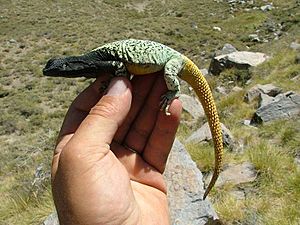Phymaturus facts for kids
Quick facts for kids Phymaturus |
|
|---|---|
 |
|
| Adult male of Phymaturus verdugo | |
| Scientific classification |
|
| Kingdom: | Animalia |
| Phylum: | Chordata |
| Class: | Reptilia |
| Order: | Squamata |
| Suborder: | Iguania |
| Family: | Liolaemidae |
| Genus: | Phymaturus Gravenhorst, 1838 |
| Diversity | |
| 52 species | |
| Synonyms | |
|
Centrura Bell, 1843 |
|
Phymaturus is a group of lizards that belong to the Liolaemidae family. This family was once thought to be part of a larger group called Iguanidae. Phymaturus is a medium-sized group within its family. As of 2021, there are about 50 known species of Phymaturus lizards, but new ones are still being found!
These lizards live in the Andes mountains and down into the Patagonia region of South America. They can be found in many different places, or habitats. Most Phymaturus lizards like to live on rocky ground. They eat plants, and they give birth to live, fully developed young, instead of laying eggs.
Different Kinds of Phymaturus
Scientists divide the Phymaturus lizards into two main groups. These groups are based on how the lizards look and where they live.
The palluma Group
This group includes several species of Phymaturus lizards. They often have certain features that help scientists tell them apart. For example, their tails might have clear spines.
Some species in the palluma group are:
- Phymaturus aguanegra
- Phymaturus bibronii
- Phymaturus darwini
- Phymaturus palluma
- Phymaturus verdugo
The patagonicus Group
The patagonicus group is another large collection of Phymaturus species. Lizards in this group often have smooth tails.
Some species in the patagonicus group are:
- Phymaturus calcogaster
- Phymaturus camilae
- Phymaturus ceii
- Phymaturus patagonicus
- Phymaturus zapalensis
There are also a few other species that scientists are still studying to see which group they fit into, like Phymaturus fiambala.
When you see a name like (Molina, 1782) after a species name, it means that the species was first described by that person, Molina, in 1782. The parentheses show that the lizard was originally placed in a different group, or genus, when it was first named.
See also
 In Spanish: Phymaturus para niños
In Spanish: Phymaturus para niños

